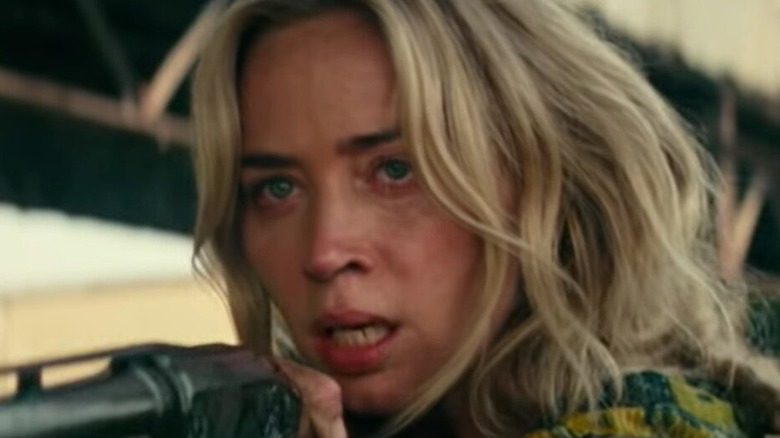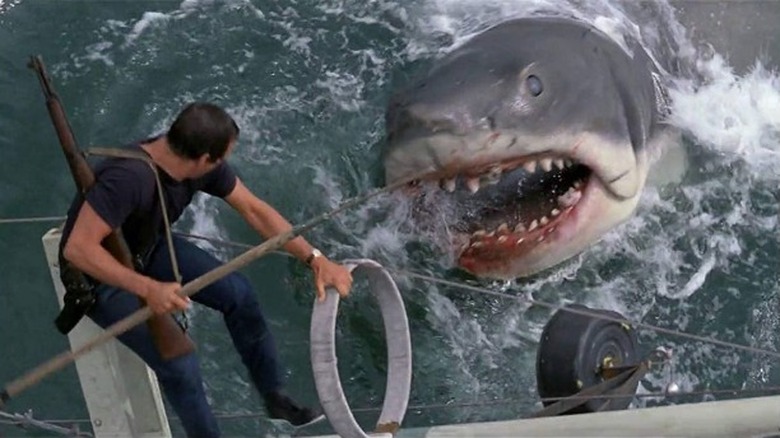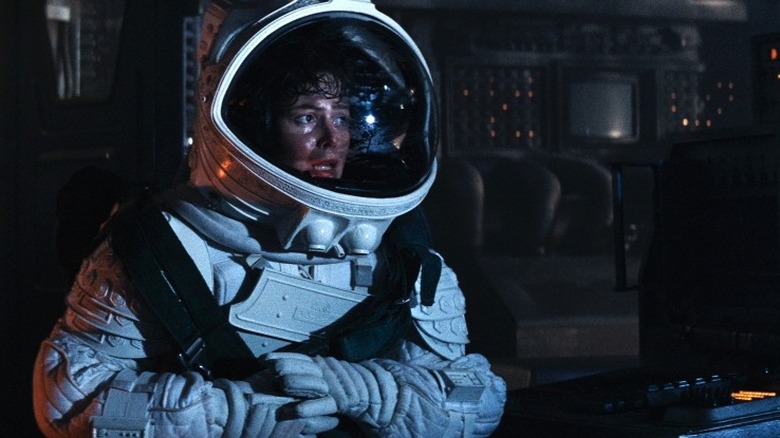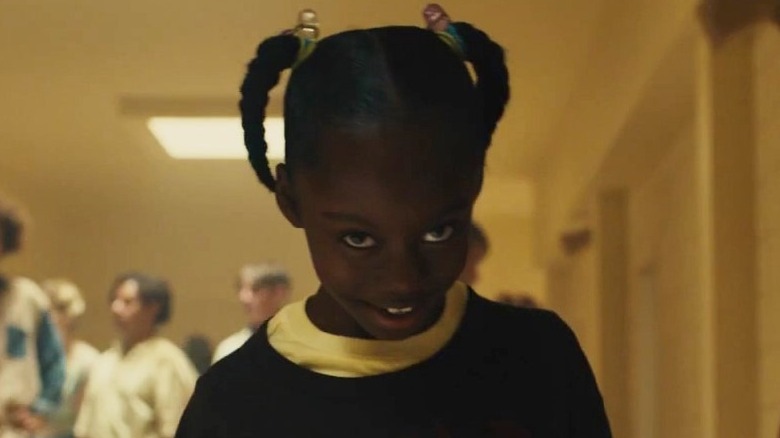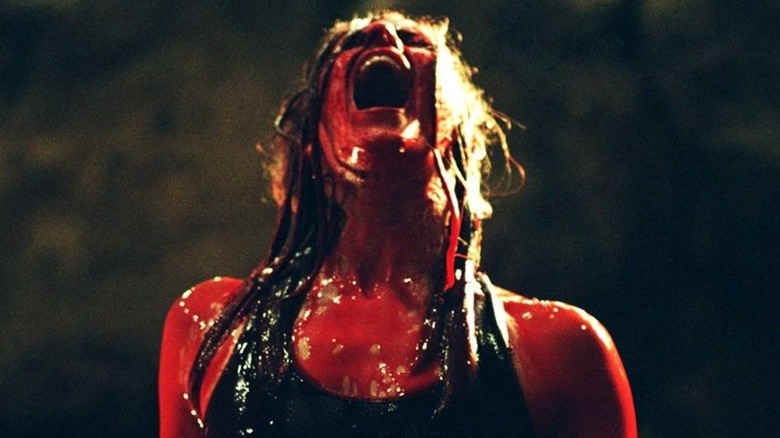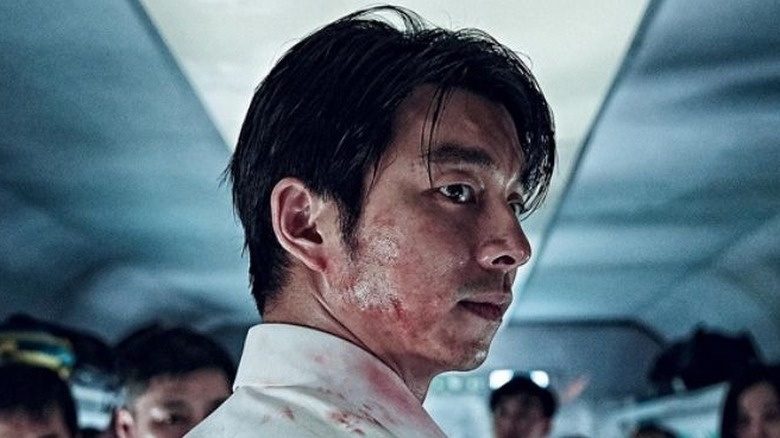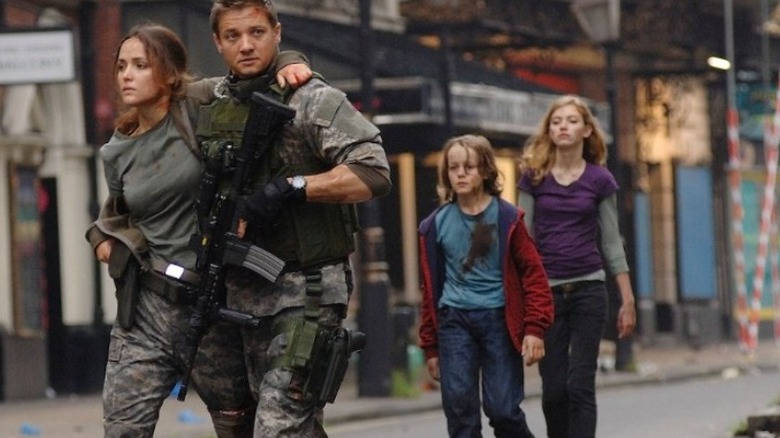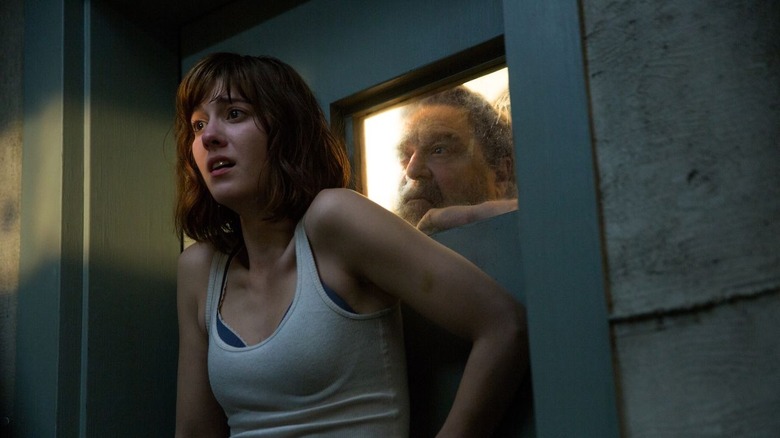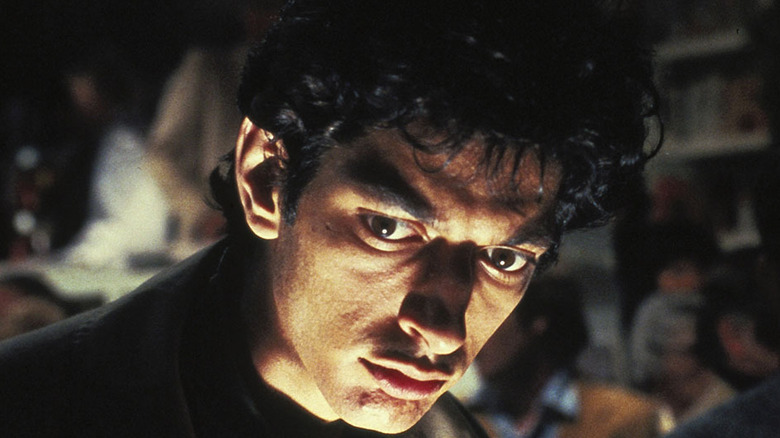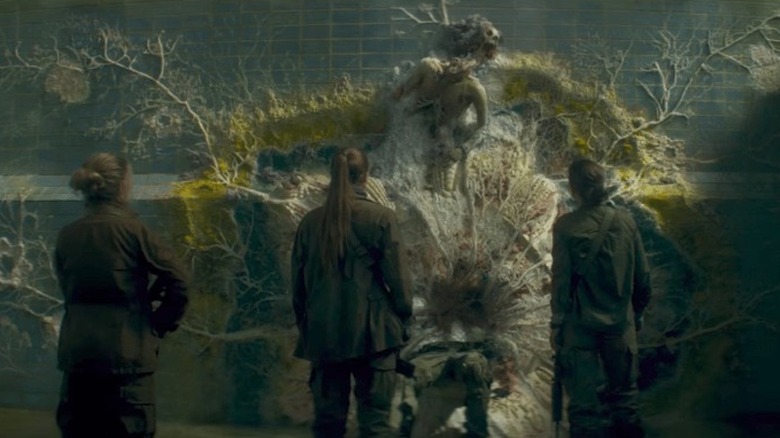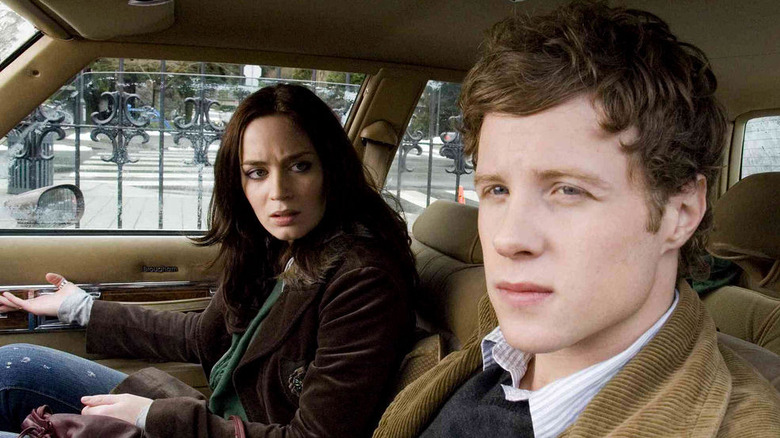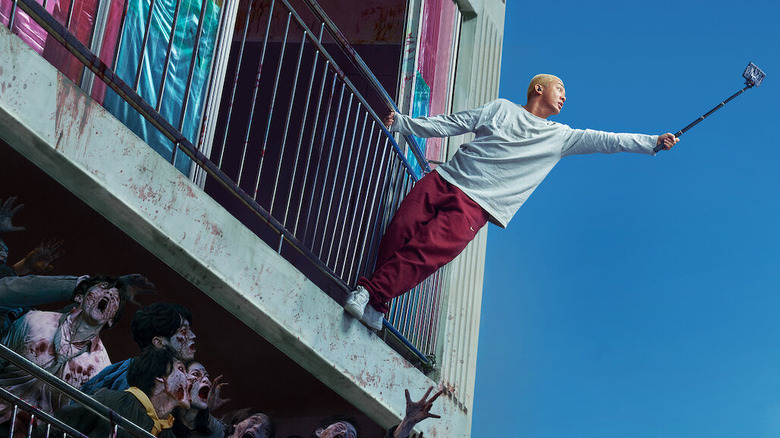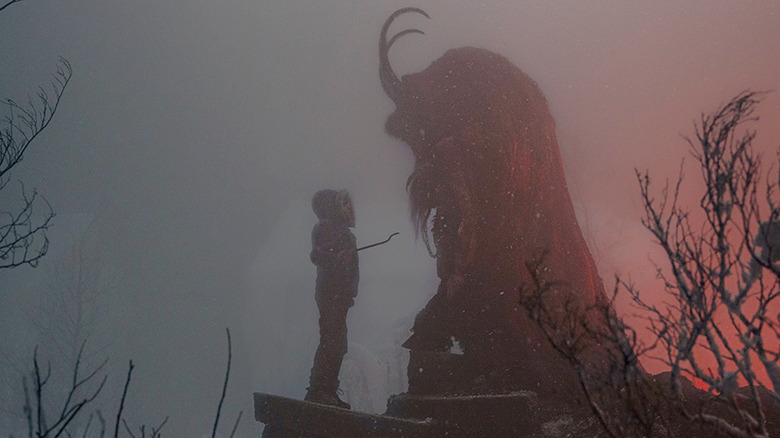Movies To Watch If You Loved A Quiet Place: Part II
"A Quiet Place: Part II" is a terrifying, post-apocalyptic creature-feature that centers on family, resilience, and love. Starring the first movie's core cast — including Emily Blunt, Noah Jupe, and Millicent Simmonds — while expanding the scope of its world and characters, Part II wisely replicates what worked so well the first time while doubling down on the series' core conceit: To stay alive, its characters must remain silent. In the world of "A Quiet Place: Part II," silence equals survival.
The move is a thrilling, heartfelt ode to horror and sci-fi's past, depicting a world where the innate goodness of others is enough to triumph over an otherworldly race of monsters. It also signals a shift in representation in genre films, with deaf star Millicent Simmonds taking the lead for the second go-round, ably matching her adult peers with resounding emotion and certified grit. Released in May 2021, and now available to stream on Paramount+, "A Quiet Place: Part II" is an unqualified success. Meaner, leaner, and more emotionally gripping than the first, it's the rare horror sequel that surpasses the original.
A third movie in the series is on the way, with Jeff Nichols taking over as director from John Krasinski, but it won't be out for a while. While you wait, here are 12 more movies to watch if you loved "A Quiet Place: Part II."
Jaws
"Jaws" is perhaps John Krasinski's preeminent inspiration for "A Quiet Place: Part II." In an interview with Den of Geek, director John Krasinski noted "I think 'Jaws' is a perfect film, and I think that, storytelling-wise, what I learned from it was simplicity, the strength that comes from simplicity." That simplicity is apparent in "A Quiet Place Part II" from the get-go, with Kransinski, not unlike Steven Spielberg himself, using technical flourishes and genuine pathos to elevate a pretty simple tale of man versus beast.
The opening prelude to "A Quiet Place: Part II" is similar to Spielberg's opening to "Jaws": A placid small town enjoys a tranquil summer right before an unseen menace descends. The tension is gripping, the unpredictability sensational, and the fear palpable. Where "Jaws" made audiences afraid of going into the water, "A Quiet Place: Part II" made them afraid to make a sound.
Alien
Director Ridley Scott's "Alien" is a classic operatic science-fiction horror hybrid that is perhaps best conceptualized as a haunted house movie set in space. Starring a then-unknown Sigourney Weaver, "Alien" follows a group of outer space contractors who, after responding to an unknown distress beacon, find themselves trapped with an alien lifeform on their ship. It's terrifying stuff, rendered all the more distressing on by Scott's stripped-down simplicity and austere posturing.
John Kransinski says he watched "Alien" to prepare for his duties on "A Quiet Place: Part II." The thematic link is especially clear in how "Part II" handles Millicent Simmonds' character, who serves as a contemporary parallel for Weaver's Ellen Ripley, the perennial horror heroine. Simmonds' Regan Abbott is resourceful, determined, and worth rooting for, not unlike Ripley. "Alien" is worth checking out, especially for fans eager to see an early model of what "A Quiet Place: Part II" would emulate.
Us
Jordan Peele's "Us" was a sensation when it was released, grossing over $255 million worldwide against a modest $20 million budget. Riding the wave of director Peele's Oscar-winning horror hybrid "Get Out," "Us" set the world aflame with an incendiary and terrifying home invasion spectacle that repeatedly subverted the audience's expectations.
It also, like "A Quiet Place: Part II" is a modest though deeply-felt effort to further diversity in the genre, and to center protagonists that look quite unlike what audiences are used to. Where "Us" starred an awards-worthy Lupita Nyong'o in dual roles, "A Quiet Place: Part II" has Millicent Simmonds. As Kenyan and deaf actresses respectively, the actresses serve as the lynchpins in smart restructurings of familiar frameworks. Both "A Quiet Place: Part II" and "Us" take old scares and make them feel new again.
Similarly, both films feature strong, cohesive family units at their centers and are told from the perspectives of families endeavoring to survive a burgeoning apocalypse. Where "A Quiet Place: Part II" has extraterrestrial monsters, "Us" has an army of underground doppelgängers who act, think, and feel just like, well, us. Director John Krasinski even remarked that, among his horror peers, "Us" was one of the movies that inspired his work on the "Quiet Place" sequel.
The Descent
Neil Marshall's "The Descent" is one of the scariest movies released this century. A riff on Ridley Scott's "Alien," though with considerably more blood and guts, it follows an all-female group of spelunkers who, after being led into an uncharted cave system, find themselves battling an ancient species of cave-dwelling humanoids. What makes these humanoids distinct — and renders the "A Quiet Place: Part II" connection all too clear — is that, on account of their underground habitat, they're blind. Instead of sight, these creatures rely on their finely-tuned hearing to monitor, track, and ultimately hunt down their prey.
The all-female angle is echoed in "A Quiet Place Part II" with Emily Blunt's Evelyn Abbott, a fierce maternal stalwart willing to do whatever it takes to keep her family safe. Indeed, Marshall's "The Descent," starring an inimitable Shauna Macdonald, looks like an early template for some of Krasinski's most effective "don't make a sound" set pieces. At one point, two of the divers (MyAnna Burning and Saskia Mulder) are trapped below a crawling humanoid, which is staring them right in the face. They hold their breaths and stifle all movement. Just when they think they're safe, Sam's watch alarm goes off. It's gloriously thrilling to watch as the duo scramble to remove the device before the creature returns. If you liked "A Quiet Place: Part II" but wished it was just a little more violent and unforgiving, this one's for you.
Train to Busan
Yeon Sang-ho's "Train to Busan" was an instant hit when it debuted on Netflix in 2016, so much so that a sequel "Train to Busan Presents: Peninsula" was released four years later. "Train to Busan" stars Gong Yoo as Seo Seok-woo, a fund manager estranged from his daughter, Seo Su-an (Kim Su-an). On Seo Su-an's birthday, the two decide to take (you guessed it) a train to Busan to see the girl's mother. En route, an infected woman boards the train, killing most all of the passengers, aside from a ragtag ensemble that includes an elderly couple, a baseball team, and a homeless stowaway.
Much like both "The Descent" and "A Quiet Place: Part II," these zombies are limited in their ability to see. Instead, they hunt by sound. It's a terrifying subversion of conventional undead tropes, one that allows for several quick chases and tense, slow crawls though armies of the undead. One wrong move and it's over. It's a wildly influential approach to zombie movies, and one that director Zack Snyder aped in his recent "Army of the Dead" for Netflix. High-octane, deeply-human, and even a bit of a tearjerker, "Train to Busan" is one not to miss.
28 Weeks Later
The world of genre filmmaking is vast and interconnected. With just a little effort, every movie can be traced to something that came out earlier. Such is the case with Juan Carlos Fresnadillo's "28 Weeks Later." The monsters in Fresnadillo's sequel, modeled after those first introduced in the original "28 Days Later," are frenzied and fast. They're also not conventional zombies. Instead, they're people who have been infected with a "rage virus" that, for all intents and purposes, makes them a lot more like the more traditional horror movie villains, only quicker and more vicious.
The family unification thread that guides both of John Krasinski's "A Quiet Place" movies is evident here, too, as Tammy (Imogen Poots) and Andy (Mackintosh Muggleton) are reunited with their father in quarantined London just as a new virus breaks out. The scares come fast and hard, as do the bonafide emotions, with familial sacrifices that hit as hard as Krasinski's in the first "A Quiet Place." Moreover, "28 Weeks Later" is a clear inspiration for Yeon Sang-ho's "Train to Busan," on account of the energized undead and the scenic, apocalyptic detours. "28 Weeks Later" might have been one of the first of its kind, but it certainly won't be one of the last.
10 Cloverfield Lane
On the other end of the spectrum is Dan Trachtenberg's "10 Cloverfield Lane." Starring genre stalwart Mary Elizabeth Winstead, an exceptionally sinister John Goodman, and the always amicable John Gallagher Jr., "10 Cloverfield Lane" is a chamber-piece, something like a peripheral "A Quiet Place: Part II" micro-narrative (despite, of course, the movie's connection to the ever-expanding "Cloverfield" cinematic universe). Shot under-the-radar with its larger franchise connections concealed until release, "10 Cloverfield Lane" still works as a standalone hybrid of sci-fi and horror that relishes in the unknown.
Winstead's Michelle is taken in by Goodman's Howard following a traumatic auto accident. Howard, however, refuses to let Michelle leave his bunker, maintaining that there has been a massive attack and that the world outside is unsafe. Michelle simultaneously believes Howard's claims while remaining incredulous, especially as Howard himself becomes increasingly threatening. Michelle must decide whether the known threat inside or the unknown one outside is worse.
"10 Cloverfield Lane," like "A Quiet Place: Part II" asks big questions about the end of the world. Rather than simply accepting survival as the ultimate goal, both movies question the efficacy of staying alive as an end in itself. What good is a world without humanity, love, and compassion? If those are sacrificed, has anyone really survived? It's heady stuff, and like "A Quiet Place: Part II," sufficiently terrifying. Just as "Part II" will have you gripping the armrests until your knuckles bleed, "10 Cloverfield Lane" is a thrill ride that doesn't let up until its glorious, wholly unexpected finale.
Invasion of the Body Snatchers
Philip Kaufman's "Invasion of the Body Snatchers" is just one incarnation of Jack Finney's seminal 1955 novel, "The Body Snatchers." The first adaptation, directed by Don Siegel, was released in 1956, followed by Kaufman's interpretation, then Abel Ferrara's "The Body Snatchers" in 1993, Robert Rodriguez's "'Scream' but with aliens" version, "The Faculty," in 1997, the Nicole Kidman vehicle "The Invasion" in 2007, and the teeny-bopper rendition, "Assimilate," in 2019. That's a lot of body snatching.
Kaufman's remake, starring Donald Sutherland and Brooke Adams, is the best of the bunch. Similar to Finney's book, in "Invasion of the Body Snatchers" a race of extraterrestrial beings flee their dying planet and land in San Francisco, taking over the planet's natural ecosystem and cultivating a legion of pods that replicate organic matter, chiefly human beings. These pods slowly yet surely replace the citizens of San Francisco with austere mimics.
The notion of an alien species colonizing our planet and stripping us of our bodily autonomy is terrifying stuff, though like with "A Quiet Place: Part II," it also provides ample opportunity for tense set pieces. Just as the ensemble of "A Quiet Place: Part II" must remain quiet to survive, the ensemble of "Invasion of the Body Snatchers" must adapt to a new world order, eschewing conventional human emotions, to avoid detection by the alien race. What good is survival, though, when something so fundamental is sacrificed?
Annihilation
Alex Garland's "Annihilation," based on the first novel in Jeff VanderMeer's "Southern Reach" trilogy, was 2018's best horror movie that no one really saw. Constrained by an unconventional release strategy that saw Paramount handle the American, Canadian, and Chinese releases while Netflix streamed the film in other territories, "Annihilation" seemed dead on arrival.
And, in a financial sense, it was. Executives worried the film was "too intellectual" (per The Hollywood Reporter), though director Alex Garland had been fortunate enough to retain final cut privilege. Thus, the "Annihilation" that audiences saw was the "Annihilation" Garland wanted them to see. Ostensibly about a team of female scientists (with Natalie Portman leading the pack) led into an anomalous zone known as the "Shimmer," "Annihilation" is heady, dense sci-fi with tinges of creature-feature horror action. There are mutated bears, albino gators, and extraterrestrial species. The temporal laws of the "Shimmer" are unconventional, and audiences will watch in awe as their filmic expectations are subverted at every turn.
"Annihilation" is quite unlike the other movies listed here. Yet, for a distinct take on the core premise of "A Quiet Place: Part II" — aliens invade earth — it's worth a watch. It's mysterious, terrifying, and recurrently baffling, but it's something special. Garland delivered a beast of a movie here, and while it won't resonate with everyone, it's worth watching, if only for the majesty of Garland's distinct vision.
Wind Chill
"A Quiet Place: Part II" is not Emily Blunt's first foray into horror. That distinction belongs to Gregory Jacobs' "Wind Chill," which Bloody Disgusting calls a "Christmastime ghost story that makes the blood run cold." A young Emily Blunt stars as "the girl," a young college student who accepts a holiday ride home from her classmate, "the guy" (Ashton Holmes) Ostensibly innocuous, things grow increasingly unnerving. "Guy" knows more about "girl" than he should, and she soon begins to suspect that his intentions are anything but pure.
The car soon crashes, and "Wind Chill" becomes a chilly (forgive me) foray into the deepest recesses of a disturbed mind, one that keeps the audience guessing. Is it a serial-killer thriller? A ghost story? Something else entirely? It's not clear until the end, yet "Wind Chill" remains consistently satisfying.
Moreover, Emily Blunt's performance is an early augur for her turn in "A Quiet Place: Part II." Her work here is a testament to how a talented performer can elevate even the most thinly-sketched character. Evelyn Abbott, much like "Girl," isn't all that developed — she's a mother who loves her children, that's all — but Blunt's work is so engaging, so deeply-felt, and so fierce that it doesn't matter. For audiences eager to see Blunt's early genre work, "Wind Chill" is a trip worth taking.
#Alive
"#Alive" is a recent Netflix original hailing from South Korea. Directed by Cho Il-hyung and starring Yoo Ah-in and Park Shin-hye, it follows Oh Joon-woo (Yoo Ah-in), a gamer and streamer who finds himself quarantined in his apartment after a zombie apocalypse breaks out. Disconnected from everyone he knows — including his family, who went out earlier in the day — his only source of hope is Kim Yoo-bin (Park Shin-hye), the mysterious woman who lives in an apartment across the quad. Together, they must learn to communicate and formulate a plan for escape before the entire complex is overrun.
"#Alive," like "A Quiet Place: Part II," features a burgeoning apocalypse and explores the lengths people will go to in order to remain not only alive, but, more importantly, connected. The undead carnage is violent and well-choreographed, but "#Alive" is just as eager to remain patient where it counts most. Entire days pass by without incident, title cards detail just how long Oh Joon-woo has been on his own, and alongside both "A Quiet Place" and "A Quiet Place: Part II," it might just be the most life-affirming apocalypse there is. For all the bloodshed and horror, people remain good, desperate to connect with others and preserve their humanity. If you want a few tears alongside your zombie mayhem, "#Alive" delivers.
Krampus
"Krampus" is the long-awaited follow-up to director Michael Dougherty's Halloween horrorfest "Trick R Treat." An all-star cast, including Toni Collette and Adam Scott, are menaced by horrific, folkloric creatures after their tyke, Max (Emjay Anthony), inadvertently summons Krampus after losing his Christmas spirit. It's a wholly unique post-apocalyptic scenario, and one that treads similar ground as "A Quiet Place: Part II," only with considerably more laughs and high jinks.
The practical effects work in "Krampus" is unmatched, including a thoroughly terrifying, monstrous jack-in-the-box, and the acting is so-well balanced as it oscillates between fear and humor that it's hard not to be swept up in the family's holiday chaos. "Krampus" is unconventional Christmas fare, but it has heart and reminds audiences that the holidays are about family more than anything. It's scary when it counts most, though, and "Krampus" is liable to be a holiday no one will forget any time soon.
